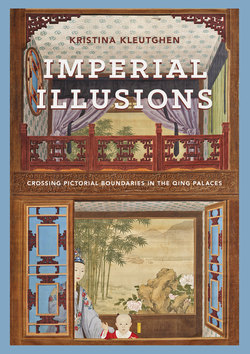Читать книгу Imperial Illusions - Kristina Kleutghen - Страница 62
На сайте Литреса книга снята с продажи.
Оглавлениеof knowledge in the full bookshelves framing the emperor, and the placement of the vanishing point on a book, emphasize Kangxi’s commitment to learning and knowledge, perhaps even implying his specific commitment to Western learning given his support of the Jesuits and Gherardini’s service to the Jesuit mission. Kangxi was a committed scholar, receiving daily lectures and tutoring from Chinese scholars on the Confucian classics, and from the Jesuits on various aspects of Western learning. By depicting a book at the vanishing point of this painting, the artist serves the imperial ideology of knowledge and study as a means of state control and a demonstration of Confucian sageliness. Rather than perspective being incorporated “as a means to visualize symbolic command and mastery of Western art,”89 therefore, its use in this imperial portrait supports a seemingly truthful presentation of his commitment to and command over knowledge, as befits an ideal emperor.
The introduction of perspective within this context of technical knowledge that served imperial power, along with works such as Pictures of Tilling and Weaving and the Portrait of Kangxi Reading, demonstrate how this pictorial technique served Kangxi’s particular political goals. Needing more of these works after Gherardini left China, Kangxi requested that another European painter specifically trained in portraiture and perspective be sent. Gherardini’s immediate successor, Matteo Ripa, S.J. (Ma Guoxian, 1682–1746), repeatedly stated that his painting skills were insufficient for Kangxi’s requirements.90 When Giuseppe Castiglione arrived in Beijing more than ten years after Gherardini’s departure, little could Kangxi have realized just how profoundly illusionistic Western painting would come to affect Qing court art.
European Artists and Pictorial Illusionism at the High Qing Court
In January 1707, the Society of Jesus registered the nineteen-year-old Milanese painter Giuseppe Castiglione as a “novice coadjutor assigned to the Chinese Province.”91 Castiglione shared several traits with Giovanni Gherardini: both were trained professional painters; neither was ordained as a priest (Castiglione remained a lay brother throughout his Jesuit career, as was common for professionals who joined the order as grown men); both developed their painting from the same Bolognese tradition of illusionistic perspectival painting; and both followed master quadraturisti. Castiglione’s professional artistic training was likely conducted within a workshop, and he claimed to work in the tradition of Jesuit quadraturista Andrea Pozzo, although there is no evidence of direct studentship.92 In 1709, Castiglione was transferred to Coimbra, Portugal, in preparation for his departure to China from Lisbon, but royal painting commissions delayed that departure until April 1714. The Coimbra paintings have disappeared, but Castiglione’s own few letters and other textual records show that he painted portraits for the royal family as well as quadratura depicting perspectival stairs and illusionistic foliage in the chapel of St. Francis Borgia in the Jesuit College.93 Precisely during that period, the Portuguese Jesuit mathematician and
